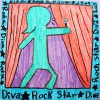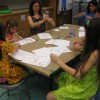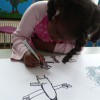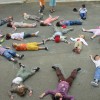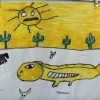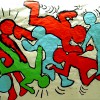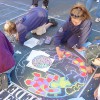- Keith Haring Murals in San Sebastián
- Keith Haring Murals
- Come To Know Keith Haring
- Organ Systems Mural
- City as Canvas: Artist Spotlight
- Printing with Objects
- Mural Making in the Style Of Keith Haring
- Subway Graffiti Project
- T-shirt Designer
- Keith Haring Semiotics Poster
- Introducing Keith Haring
- Discovering Keith Haring
- Haring Inspired Mural
- All Bottled Up!
- Thinking about Drawings as Symbols
Subject | Performance
Snapshots
Inspired by work Haring explored throughout his life, this project asks students to photograph one another and reflect upon what they see both externally and internally.
Morphs
This lesson, similar to our Flip-Book lesson, is designed for children to explore movements and perform them as the different characters in Haring's work, emphasizing transitional poses and personal expression.
Pop Art People
A lesson especially designed for younger children to help them understand body proportion and construction.
